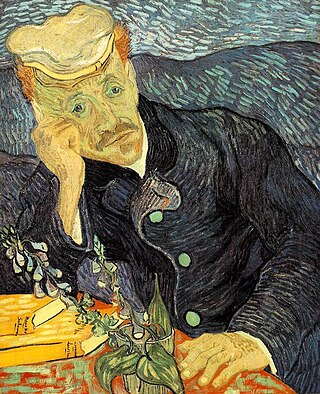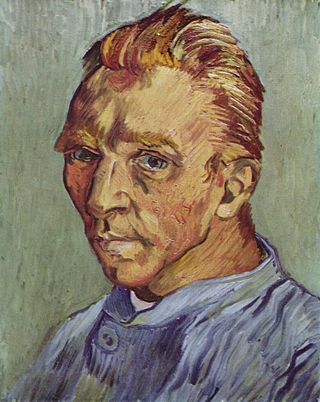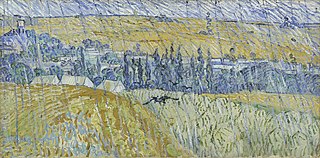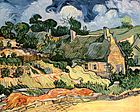
The Musée d'Orsay is a museum in Paris, France, on the Left Bank of the Seine. It is housed in the former Gare d'Orsay, a Beaux-Arts railway station built between 1898 and 1900. The museum holds mainly French art dating from 1848 to 1914, including paintings, sculptures, furniture, and photography. It houses the largest collection of Impressionist and post-Impressionist masterpieces in the world, by painters including Berthe Morisot, Claude Monet, Édouard Manet, Degas, Renoir, Cézanne, Seurat, Sisley, Gauguin, and van Gogh. Many of these works were held at the Galerie nationale du Jeu de Paume prior to the museum's opening in 1986. It is one of the largest art museums in Europe.
The year 1890 in art involved some significant events.

Portrait of Dr. Gachet is one of the most revered paintings by the Dutch artist Vincent van Gogh. It depicts Dr. Paul Gachet, a homeopathic doctor and artist with whom van Gogh resided following a spell in an asylum at Saint-Rémy-de-Provence. Gachet took care of Van Gogh during the final months of his life. There are two authenticated versions of the portrait, both painted in June 1890 at Auvers-sur-Oise. Both show Gachet sitting at a table and leaning his head on his right arm, but they are easily differentiated in color and style. There is also an etching.

The portraits of Vincent van Gogh (1853–1890) include self-portraits, portraits of him by other artists, and photographs—one of which is dubious—of the Dutch artist. Van Gogh's dozens of self-portraits were an important part of his œuvre as a painter. Most probably, van Gogh's self-portraits are depicting the face as it appeared in the mirror he used to reproduce his face, i.e. his right side in the image is in reality the left side of his face.

Theodorus van Gogh was a Dutch art dealer and the younger brother of Vincent van Gogh. Known as Theo, his support of his older brother's artistic ambitions and well being allowed Vincent to devote himself entirely to painting. As an art dealer, Theo van Gogh played a crucial role in introducing contemporary French art to the public.

The Church at Auvers is an oil painting created by Dutch post-impressionist artist Vincent van Gogh in June 1890 which now hangs in the Musée d'Orsay in Paris, France.

Auvers-sur-Oise is a commune in the department of Val-d'Oise, on the northwestern outskirts of Paris, France. It is located 27.2 km (16.9 mi) from the centre of Paris. It is associated with several famous artists, the most prominent being Vincent van Gogh (1853–1890). This was the place where van Gogh died.

L'Arlésienne, L'Arlésienne : Madame Ginoux, or Portrait of Madame Ginoux is the title given to a group of six similar paintings by Vincent van Gogh, painted in Arles, November 1888, and in Saint-Rémy, February 1890. L'Arlésienne means literally "the woman from Arles".

Paul-Ferdinand Gachet was a French physician most famous for treating the painter Vincent van Gogh during his last weeks in Auvers-sur-Oise. Gachet was a great supporter of artists and the Impressionist movement. He was an amateur painter, signing his works "Paul van Ryssel", referring to his birthplace: Rijsel is the Dutch name of Lille.
Vincent van Gogh lived during the Impressionist era. With the development of photography, painters and artists turned to conveying the feeling and ideas behind people, places, and things rather than trying to imitate their physical forms. Impressionist artists did this by emphasizing certain hues, using vigorous brushstrokes, and paying attention to highlighting. Vincent van Gogh implemented this ideology to pursue his goal of depicting his own feelings toward and involvement with his subjects. Van Gogh's portraiture focuses on color and brushstrokes to demonstrate their inner qualities and Van Gogh's own relationship with them.

Décoration for the Yellow House was the main project Vincent van Gogh focused on in Arles, from August 1888 until his breakdown the day before Christmas. This Décoration had no pre-defined form or size; the central idea of the Décoration grew step by step, with the progress of his work. Starting with the Sunflowers, portraits were included in the next step. Finally, mid-September 1888, the idea took shape: from this time on he concentrated on size 30 canvases, which were all meant to form part of this Décoration.

"Vincent and the Doctor" is the tenth episode of the fifth series of British science fiction television series Doctor Who, first broadcast on BBC One on 5 June 2010. It was written by Richard Curtis and directed by Jonny Campbell and featured an uncredited guest appearance from actor Bill Nighy.

Dr. Gachet's Garden in Auvers and Marguerite Gachet in the Garden were both painted in 1890 by Vincent van Gogh in the gardens of his homeopathic physician, Dr. Paul Gachet. Both paintings reside at the Musée d'Orsay.

Old Church Tower at Nuenen are names given to several oil paintings and drawings created in 1884 and 1885 by Vincent van Gogh. Most reflect the way the 12th-century church looked in its better days when its spire was intact and its foundation formidable. The spire was demolished in 1792 and the church tower was in the process of being torn down and sold for scrap as Van Gogh made the paintings.

Dutch Post-Impressionist painter Vincent van Gogh painted a self-portrait in oil on canvas in September 1889. The work, which may have been Van Gogh's last self-portrait, was painted shortly before he left Saint-Rémy-de-Provence in southern France. The painting is now at the Musée d'Orsay in Paris.

Houses at Auvers is an oil painting by Vincent van Gogh. It was created towards the end of May or beginning of June 1890, shortly after he had moved to Auvers-sur-Oise, a small town northwest of Paris, France.

Landscape at Auvers in the Rain is an oil painting on canvas by the Dutch Post-Impressionist painter Vincent van Gogh.

Hyacinthe-Eugène Meunier, known as Eugène Murer, was a pastry chef, author, self-taught painter and collector of impressionist paintings.

Marguerite Gachet was a French woman who was painted by Vincent van Gogh in two paintings.

The Siesta is an oil on canvas painting by Vincent van Gogh painted between December 1889 and January 1890 while he was interned in a mental asylum in the French town of Saint-Rémy-de-Provence. It is part of the permanent collection of the Musée d'Orsay, in Paris.
























